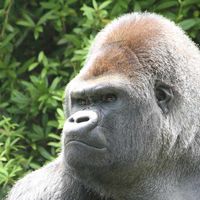« No two gorilla noses are the same! »
An awe-inspiring primate
A silver back, but a heart of gold!
The gorilla is the largest of the apes. Males can weigh up to 250 kg! The adult male is much larger in stature than the female. Its head is much bulkier, and when it reaches adulthood, the male’s backs turn grey. This has earned the adult male the nickname “silverback”. But despite its impressive build, this mountain of muscle is in fact one of the most peaceful of the great apes. When a male shouts, rises up on his hind legs, and beats his chest, it is intended to intimidate rather than to be a form of outright aggression.

Did you know?
Our females reintroduced in Gabon
Follow the Beauval Nature expedition which reintroduced 2 female gorillas born at the ZooParc de Beauval, Mayombé and Kuimba, back into the wild. Against a backdrop of breath-taking landscapes, experience the emotional rollercoaster endured by our team, from the departure from the zoo to the first few steps on the island!
Beauval Nature protects the western lowland gorilla in Africa
The western lowland gorilla is an emblematic African animal and is classified as a critically endangered species.
Hunted for their meat and falling victim to poaching and trafficking, western lowland gorillas have practically disappeared from their natural habitats. A programme has been set up that is managed by the Aspinall Foundation and supported by the Beauval Nature association.
The objectives of which are: the reintroduction and monitoring of gorillas seized by the authorities or born in European zoos, and the collection of young gorillas whose mothers were victims of poaching.
This programme placed 1st in the “Conservation” category of the People’s Choice Award, 2019.

Asato, the patriarch
Asato is the head of a large family.
This gorilla dad, who is a both a mediator and protector rolled into one, maintains order.
His family recently increased in number with the birth of two young males: M’Baku on October 27, 2018 and Kovanga 6 months later, during the night of March 15, 2019.


Sponsor our Western lowland gorillas
Establish a strong bond with your favourite animal whilst supporting conservation programmes through the Beauval Nature association!
Critically endangered
Learn more about the species
-
OmnivoreDiet
-
8½ to 9 monthsGestation period
-
1 youngLitter size
-
Lowland tropical forestsHabitat
Forget the bananas!
A unique nose
Family life

Take full advantage of the experience thanks to our mobile application!
Find out more










